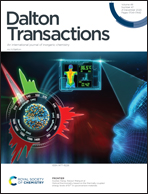Proton transfer in polyamine–P2Mo5 model adducts: exploring the effect of polyamine cations on their proton conductivity†
Abstract
Constructing acid–base pairs is one of the efficient strategies for the design of proton conductors with high conductivity, due to the ultrafast proton-hopping with a low energy barrier between a proton donor (acid group) and an acceptor (base group). In this study, an acid–base adduct polyamine–P2Mo5 model system was established, including adducts [C6N4H22][H2P2Mo5O23]·H2O (P2Mo5-TETA), [C4N3H16]2[P2Mo5O23]·H2O (P2Mo5-DETA), and [C2N2H10]2[H2P2Mo5O23] (P2Mo5-EN), (TETA = triethylenetetramine, DETA = diethylenetriamine, EN = ethanediamine). Proton conductivity analyses showed that adduct P2Mo5-EN exhibited the highest proton conductivity 1.13 × 10−2 S cm−1 at 65 °C and 95% RH, which was one and three orders of magnitude greater than those of P2Mo5-DETA and P2Mo5-TETA under the same conditions. Ea values of all three adducts are lower than 0.4 eV, which indicates that their proton transfer is attributed to the Grotthuss mechanism. Combined with visual structure analysis, the proton transport pathways of three adducts are highlighted. Moreover, we use this model system to discuss in detail the effect of pKa, proton density and size of polyamine molecules on the proton conductivity of organic amine-POM adducts.



 Please wait while we load your content...
Please wait while we load your content...